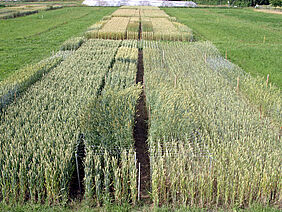In the past decades, wheat breeding on a global scale was strongly focused on grain yield improvement to limit starvation. Focusing on yield improvement, wheat breeders tended to neglect to breed for cultivars achieving high grain yields at low nutrient supply, which means using available nutrients most efficiently. This development might have resulted in a shift of the optimum nutrient level for wheat cultivation and thus led to cultivars with an increasing demand for nutrient supply. This recently finished Ph.D. researched whether those modern cultivars selected for high input farming are also suitable for growing under the nutrient restricted conditions in organic farming.
This study assessed the need of specific breeding programs for organic farming. The general hypothesis was that cultivars selected under organic conditions are better suited to organic farming than cultivars selected under conventional high input conditions. Two one year field studies were carried out in a total of seven environments with eight to ten wheat cultivars. Wheat cultivars were assessed in organic and conventional systems of the DOK long-term field trial in 2007, where different farming systems are compared since 1978. In 2008 these cultivars were assessed under practical farming conditions (replicated on-farm trials) at three organically managed farms in different pedo-climatic regions. In contrast to the fertile DOK site on loess soil, the organic farms were located at more marginal sandy or sandy loamy soils with a lower inherent yield potential.
The main objectives were (i) to compare yield, baking quality and several parameters of nutrient use efficiency of modern winter wheat cultivars derived from organic and conventional breeding programs as well as old cultivars in organic and conventional systems of the DOK long-term field trial, (ii) to compare the performance of a set of these cultivars at three on-farm trials at organically managed farms at more marginal sites, (iii) to analyse phenotypic stability of selected traits and (iv) to assess the root colonization with arbuscular mycorrhizal fungi (AMF-RC) and the correlation between AMF- RC and nutrient concentration of P, Manganese (Mn) and Zinc (Zn) in plant tissue and in the grain, nutrient uptake and grain yield.
The most important results of the study can be summarized as follows:
- Grain yields were higher under conventional than under organic conditions at the fertile DOK site in 2007.
- Baking quality parameters clearly increased from old to modern organically and conventionally bred cultivars in all test environments (biodynamic and conventional using exclusively mineral fertilizer).
- Nitrogen use efficiency was higher under organic than under conventional conditions and increased with the year of release of the cultivars.
- No significant genotype x environment interactions for agronomically important traits were observed comparing the organic and conventional systems at the fertile DOK site in 2007. In contrast, significant interactions were detected among the three marginal on-farm trials in 2008 and in the combined analysis across all seven conventionally and organically managed sites. This emphasizes the importance of selection under the adequate target environments. Screening and selection should not only be performed under organic farming but various pedo-climatic conditions, including also more marginal soils.
- Regarding the stability of grain yield and nutrient use efficiency, a cultivar suitable for organic farming should respond dynamically to the given environmental conditions. Such a dynamic behaviour would be expressed by having good performance under marginal conditions and a constant increase from the marginal sites to the fertile DOK sites. In contrast, a static stability is required for baking quality, i. e. the gluten index. For such a parameter, a genotype should achieve stable values across a wide range of environments. One organically bred cultivar was identified, which was stable for all three traits (yield, nutrient use efficiency, baking quality) simultaneously. However, it was not possible to relate the stability to the different breeding categories.
- Root colonization of wheat cultivars with mycorrhiza fungi was significantly higher in the organic than in the conventional systems. This study could not confirm the hypothesis that modern conventionally bred wheat cultivars may have lost the ability to form AMF symbiosis during breeding for high input conditions.
In conclusion, this study strongly indicates the need for organic selection environments, at least in later generations of wheat breeding, when selection for grain yield takes place.
More information
Contact
- Isabell Hildermann, FiBL, Frick
Dissertation
- Hildermann, Isabell (2010) Performance of Winter Wheat Cultivars in Organic and Conventional Farming Systems. PhD thesis, Botanisches Institut, Sektion Pflanzenphysiologie an der Universität Basel
Literature
- Literature on the DOK trial at Organic Eprints
- Shop.FiBL.org: Organic farming enhances soil fertility and biodiversity. Results from a 21 year old field tria. FiBL Dossier, 2000.




